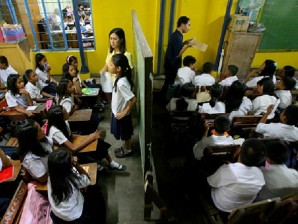QC school division turns to home study program to ease crowded classrooms

Two classes share one blackboard to save space due to lack of classrooms at the Payatas Elementary School in Quezon city. INQUIRER FILE PHOTO/MARIANNE BERMUDEZ
MANILA, Philippines—As public school students again face crammed classrooms this school year, one of the country’s most populated school divisions is turning to home schooling to ease the congestion.
The Quezon City school division is placing some 10,000 students from six crowded high schools in a home schooling program to prevent overcrowding in classrooms, officials said Thursday.
“There are 10,000 students from six high schools that will go on home study. Our city government has already allocated P20 million for that,” said Rowena Cacanindin, Quezon City assistant schools division superintendent.
“We’ve explained it to the parents and they understand the system. We’ve been doing it for three years and our students do well. They graduate, go to college and even go abroad,” Cacanindin said on the sidelines of a school inspection in Cubao, Quezon City on Thursday.
Home study is one of the Alternative Delivery Modes the DepEd recommends for schools with excess enrollment, particularly those in urban centers.
Under the program, students learn their lessons at home using modules based on the regular curriculum and meet with teachers only on Saturdays. Students who take this track graduate with a high school diploma just like any other regular student.
QC high schools that will implement the system this school year are Batasan Hills National High School, Commonwealth National High School, Holy Spirit National High School, Dona Rosario High School, North Fairview High School and Judge Feliciano Belmonte Sr. High School.
Quezon City is Metro Manila’s largest school division with at least 500,000 students enrolled in public schools every year.
At the Batasan Hills National High School, where classroom congestion is perennial, school officials are targeting a more forgiving classroom to student ratio of 1:60 by “farming out” at least 3,000 students through the home study program.
“The projected number of students is 13,450 this school year. We can accommodate 10,000 while the 3,450, we are farming out to the home study program,” Cacanindin said.
The Batasan high school campus, just a stone’s throw from Congress, has 112 classrooms, including 16 additional rooms in a just constructed building. Officials are estimating that the crowding this year would be eased, with 60 students in one classroom per shift.
The school would, however, continue to implement a two-shift schedule. The ideal classroom to student ratio is 1:45.
DepEd estimates the total public school student population this year to increase by one million, with an expected total enrollment estimated at 21 million, said Assistant Secretary Jesus Mateo.
He said that while some of the resource shortages remain, DepEd continues to address the “challenges, instead of problems” year by year, among them school crowding.
“Our classroom to student ratio is improving. But let us not compare the situation in Metro Manila to that in other place. It’s not a mirror of what’s happening in the provinces,” said Mateo in a press conference at the Ramon Magsaysay High School on Thursday.